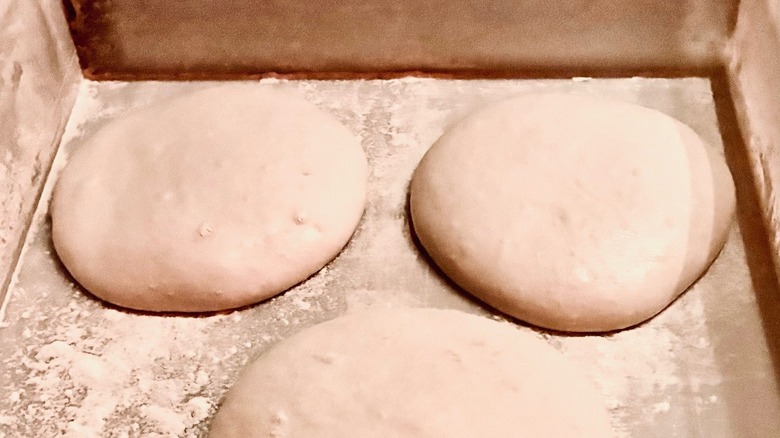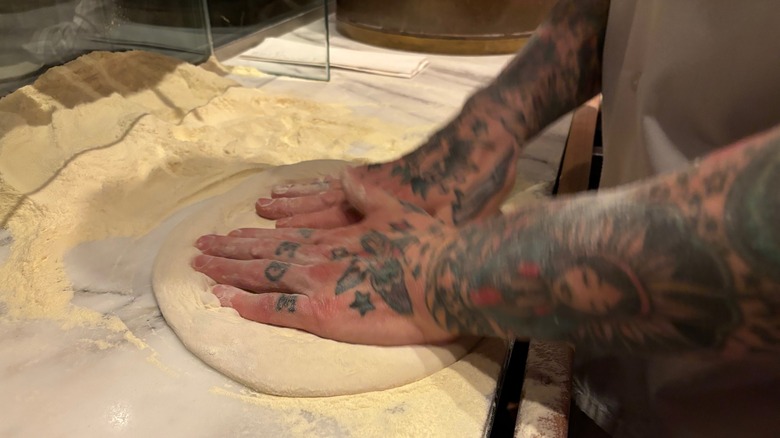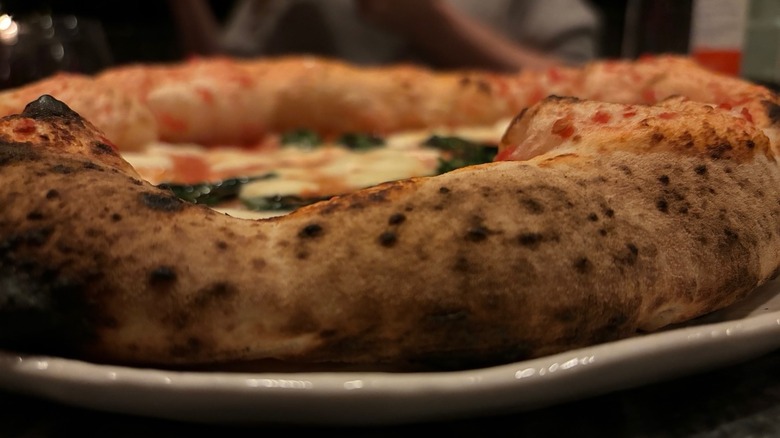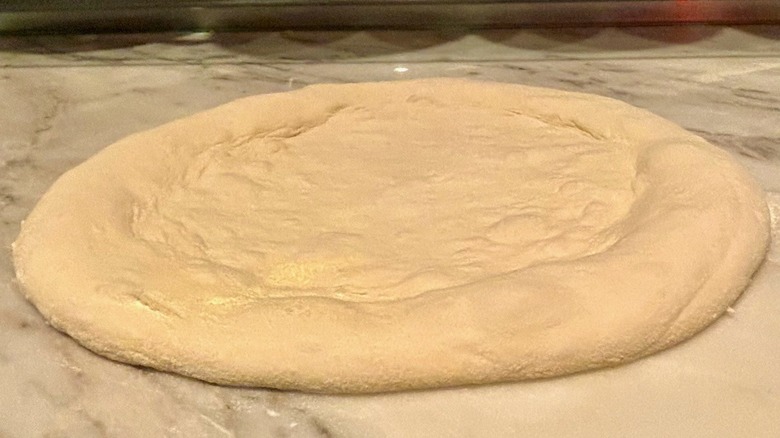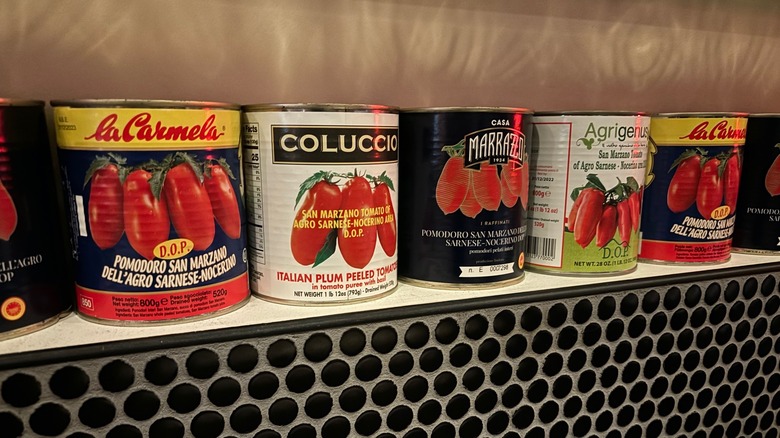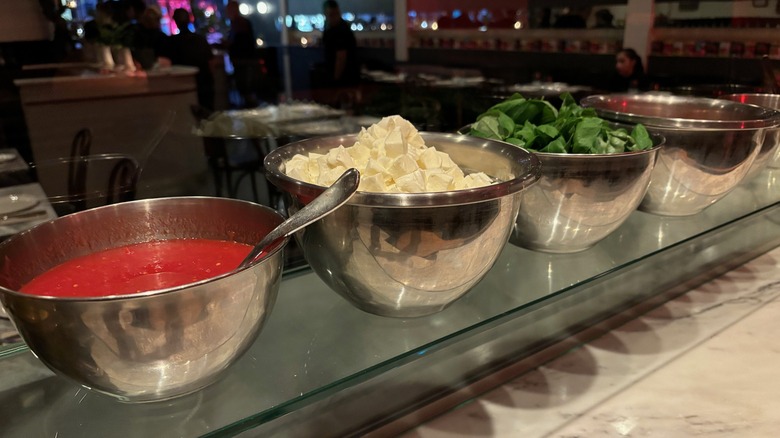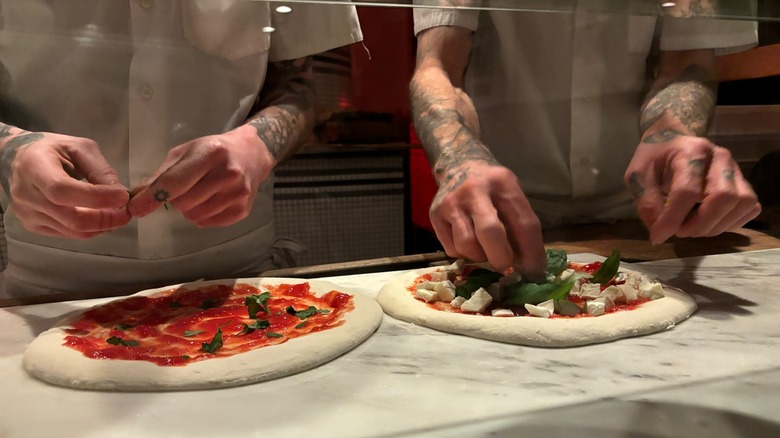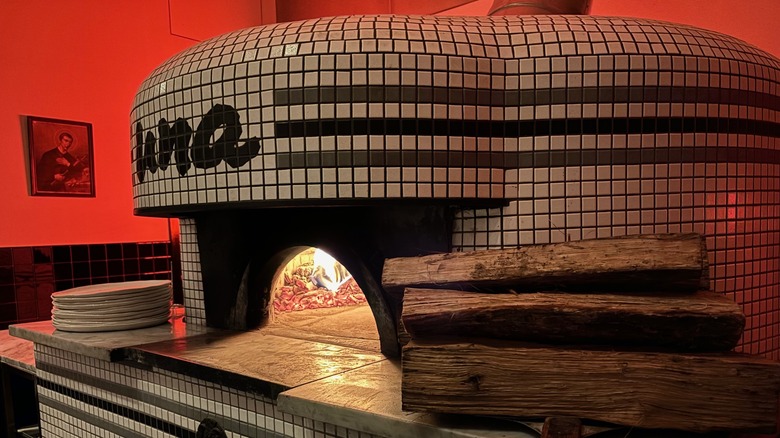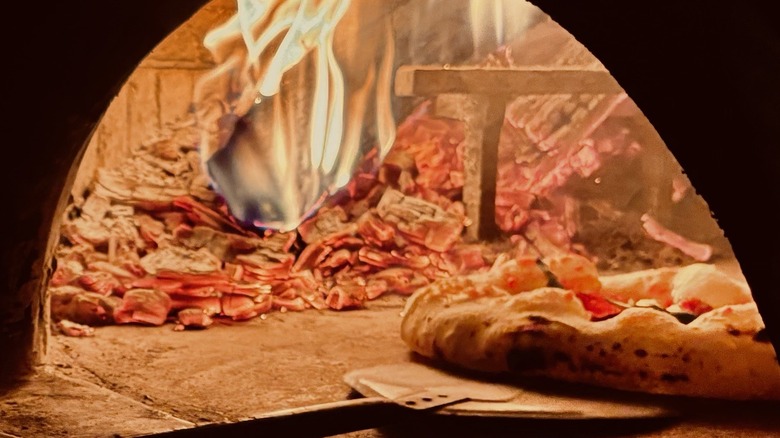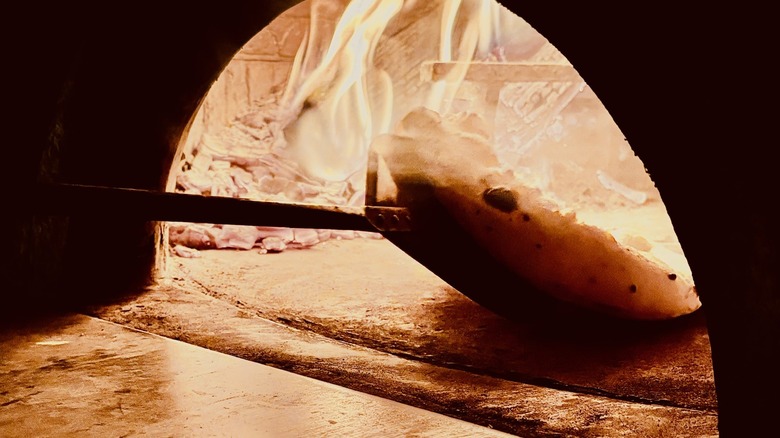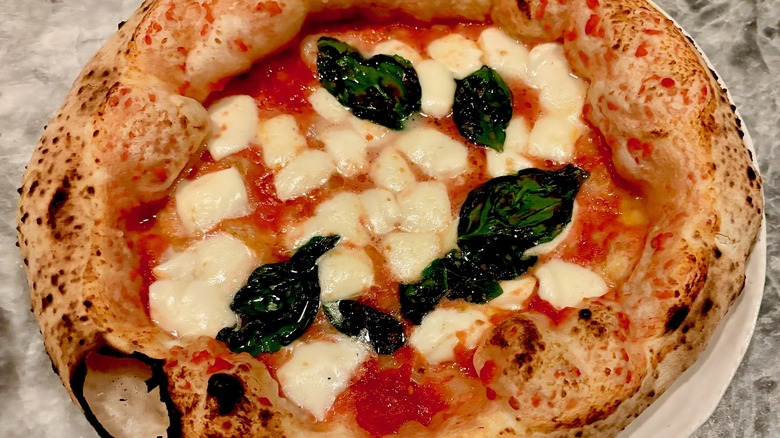How To Make The Perfect Neapolitan Pie, According To Pizza Legend Anthony Mangieri
Neapolitan pizza is a pizza unlike any other, from its signature size, shape, and taste to the dedication of making it just right. In fact, there are very specific and official international regulations of Neapolitan pizza that touch on every aspect of the pizza-making process through the Associazione Verace Pizza Napoletana. The requirements cover everything from the type of ingredients that can be used and their origin to the size, thickness, and colors of the pizza dough and toppings.
Sure, you can read these requirements and guidelines, but what does it really take to translate the words into a superb, steamy, fresh pizza? What needs to happen to create the Neapolitan's signature fluffy, thick, soft rim of dough mottled with dark spots from a blazing hot oven? To dig deeper into what makes an excellent Neapolitan pizza, we spoke with pizza master Anthony Mangieri of Una Pizza Napoletana in New York City to find out more.
Mangieri opened the first iteration of Una Pizza Napoletana in 1996 in New Jersey. While the location has changed several times since then, Mangieri's dedication to naturally leavened, wood-fired pizzas has remained consistent. The current location opened in March 2022, and 50 Top Pizza ranked it the No. 1 pizzeria in the world that same year. It features a small, carefully curated menu centered around the pizzas. The open décor lets you watch the pizzas get carefully stretched, topped, and baked, only three at a time in the large wood-fired oven.
Use the correct flour or blend for the best crust
Every type of flour has its own protein and gluten content, texture, and flavor. There are two main routes you can go when making the dough for a Neapolitan pizza. Of these slightly different ways, Anthony Mangieri says, "The two things happening were always there, but now it's now been broken out into two styles. One is thinner, and one is puffier. One cooks faster and one [a] tiny bit slower, but still, both are very fast. The two styles play into the flour you use."
The thinner style sticks with the traditional choice of 00 flour. This flour is finely ground and is a common choice for pasta and pizza doughs due to how it hydrates and its structure. The high protein and low gluten content of 00 flour means that when you hydrate and knead it, the dough will be strong yet pliable, making it easy to stretch thin without tearing, and becoming very crispy when baked. The second puffier style still uses 00 but incorporates a second flour, as well, for a slightly different flavor and texture.
While Mangieri sometimes experiments with what the second flour is, he finds the best results when sticking with 00 and 0 flour. 0 flour is only a little coarser than 00, likely imperceptible to the touch, but it's enough to make a difference in the finished dough. If possible, stick with Italian brands of 0 or 00 flour, as Mangieri has found the American brands don't perform as well.
Try mixing the dough by hand
Is it more work to make dough by hand? Absolutely. It can also be sticky, messy, and tiring. It's easy to accidentally underwork the dough or add too much flour when working with a tacky dough to make it less messy or tiring. It is one of the reasons many people prefer to use a machine. While some bread dough recipes perform well when made in a food processor or when mixed on a low setting in a stand mixer, sometimes you need to feel the dough and understand how it is developing and hydrating to get the correct finished result.
"It's not a super hydrated dough," says Anthony Mangieri of Neapolitan pizza dough, adding, "People talk a lot about combining specific ratios of flour and water, but hydration is about how it is mixed and refrigeration, as well." He goes on to explain that a hand-mixed dough and a mechanically mixed dough can yield very different results, even using a similar recipe. This is why Mangieri sometimes puts the mixer aside and goes back to making the dough by hand at the restaurant, even though it takes a lot more time. It ensures the dough is still exactly how he wants it.
The best dough will not be refrigerated
There is a reason why prepared store-bought pizza dough needs to be brought to room temperature before stretching, rolling, or baking, even though it is a hearty product. Refrigerating the dough extends its shelf life but also tightens the dough structure, making it harder to stretch and roll without having it snap back on you. Refrigeration also has an impact on the baked texture and flavor.
Traditionally, Neapolitan dough is made in the morning, left out to proof during the day, and stretched and cooked in the evening. Whether using yeast or natural fermentation, Anthony Mangieri says, "Neapolitan dough needs a long fermentation, and I never refrigerate the dough." When a yeasted dough is refrigerated, it slows the rising and firms up the dough. It will not have the same light, bubbly texture as a room temperature dough, and that can impact how it bakes. Mangieri explains, "Leoparding of the crust [a pale dough mottled with dark spots] has always been a hallmark, but now maybe that is being disproven as a good thing to have and often indicates a cold dough that is not rising right or baking evenly."
A properly risen dough, however, will boast an even golden-brown color on the bottom and sides of the dough, along with some uneven, dark spots.
How you shape the dough matters
If you can toss the dough around casually or do aerial tricks, you are not working with proper Neapolitan-style dough. Maybe a rolling pin is the right tool? Absolutely not. When you read that Neapolitan dough is light and proofs for a long time, what that really means is that the dough is infused with a lot of air bubbles in order to create a thick, puffed rim of dough that is still light on the inside and a little crisp. Mishandling the dough when it is time to shape an individual pizza will undo hours of work that you can't get back.
Anthony Mangieri clarifies that the style of dough you are working with can help dictate how to handle it. "The thinner style of dough will be able to be handled rougher around the edge," he tells us. "This is shaped the way you often see when they pick up an edge and slap the dough. The thicker style is shaped right on the table and picked up less. At its worst, even a cold dough should still be delicate enough that you can't pick it up and handle it."
The smaller size of a Neapolitan pizza and having a relaxed dough makes shaping quick work. When you can shape your pizza with just a few motions, it also helps prevent overworking the dough and accidentally deflating it.
Keep the sauce simple
There is no need to labor over a long-simmered sauce for Neapolitan pizza. Actually, please do the opposite and never pre-cook the sauce. Anthony Mangieri says that cooking the tomatoes first dulls their flavor. Of cooking the sauce, dough, and toppings at the same time, however, he explains, "The idea is that it cooks in the oven and cooks and fuses together into a perfect balance."
There are two foundational sauces for Neapolitan pizza, and both start with canned Italian San Marzano tomatoes. For a margherita pizza, the tomatoes are crushed into a slightly chunky sauce and sometimes salted, and that's it. Mangieri doesn't even use salt in his sauce. Seasoning the assembled pizza, rather than the sauce, allows him to play with robust toppings like olives, anchovies, and capers without worrying about the pizza tasting too salty. It also keeps the pure tomato flavor bright, fresh, and tangy.
On a marinara pizza, the crushed tomatoes are more robustly seasoned with the addition of oregano and fresh chopped garlic. Mangieri says, "While you can add other stuff, these are the two foundational sauces. To make it spicy, you just add some chili oil or pepperoncino on top and bake. There are no limits to what you can do, but the foundational stuff remains."
The cheese needs to be fresh
The two cheeses traditionally used on Neapolitan pizza are fior di latte and buffalo mozzarella. Both of these are fresh, very creamy cheeses, but fior di latte, which translates to "milk's flower," is made from cow's milk, while buffalo mozzarella, not surprisingly, comes from buffalo milk. Anthony Mangieri tells us that most Neapolitan pizza in Italy will be topped with fior di latte, with buffalo mozzarella used at an additional cost. When choosing which cheese to use, flavor is a consideration, but the consistency of the cheese is more important. Fior di latte is most similar to fresh mozzarella, though much creamier and with more moisture. Buffalo mozzarella has a stronger flavor, with a hint of sharpness from the milk, and isn't quite as perishable. However, as Mangieri says, "Fior di latte needs to be used the day it's made. As it sits, it changes dramatically and isn't right."
While some American companies make fior di latte and high-quality fresh mozzarella, Mangieri feels, "No one makes it right in the U.S. The flavor and texture just isn't there. Once you bake them on pizza, the composition changes, and it's just not at the same level as in Italy. Even the buffalo mozzarella we get here is several days old. But if you cut it up and drain it, it will have a beautiful texture."
Top wisely
A great Neapolitan pizza needs little more than sauce and/or cheese, but that doesn't mean you can't add other toppings. Anthony Mangieri says, "Anything goes in terms of other toppings. Maybe in the old days, you [would] see the [staples] of Southern Italian cuisine and nothing else. Maybe anchovy or fresh mushroom or olives with pits. Now you can find anything you want." Even when asked if pineapple would be forbidden, Mangieri quickly spouts off a combination that he thinks would make a delicious topping (hint: it involves mortadella).
When choosing a pizza topping, consider how the flavors will blend with the sauce and cheese once baked, and avoid adding so much that any one ingredient takes over and hides another. Each element should be able to be tasted independently of each other. It is also important to consider Neapolitan-style dough when topping. Neapolitan pizza has a thick edge but a thin middle that is more delicate and could easily become soggy or weighed down with too many toppings or toppings that have too much moisture. At Una Pizza Napoletana, Mangieri offers only four options for toppings: pepperoni, salted Italian anchovies, Calabrian long hot peppers, and a 36-month-old DOP Parmigiano Reggiano.
A wood-fired oven is still best
A wood-fired oven is the traditional way to cook a Neapolitan pizza, and even though there are coal ovens, home outdoor pizza ovens, and even some new electric ovens that can produce similarly high-temperature cooking, a wood-fired oven is still the best option for a few different reasons.
The first may be the most obvious: the flavor. "The smell and scent from a wood-fired oven can't be replicated," says Anthony Mangieri. The second is the way the wood heats the oven. There are three different heat sources in a wood-fired oven: the burning wood itself, the heat of the oven floor, and the heat of the air in the oven. These three elements work together to create a unique cooking environment. Mangieri tells us that a wood-fired oven is "not as dry of a heat as other ovens," adding, "It's a moister environment that keeps the pizza from drying out."
The direct heat puffs and lightly chars the signature thick edge so it is both crisp and light. The oven floor quickly browns the thin bottom, and the air circulates the heat between the two. Home outdoor pizza ovens have risen in popularity for their more compact size and ability to cook at a very high temperature. Mangieri cautions that their small size and high heat make it difficult for the heat to circulate and leave little room for error when trying to achieve similar results to a wood-fired oven.
The heat of the oven matters but you can't set it and forget it
There is no one ideal temperature to cook a Neapolitan pizza. Yes, it absolutely needs to be very hot since a Neapolitan pizza cooks very quickly, usually averaging between 1 and 1.5 minutes total. Anthony Mangieri aims for between 850 and 900 F before starting to cook pizza. Compared to 500 to 550 F for something like a Detroit-style pizza in a home oven, and you begin to understand just how hot the wood-fired oven is. Mangieri tells us, "You have to adjust daily and through the course of the night to get it just right. The oven is an ongoing stress. Sometimes, it's all right, but as the dough over-proofs and gets sticky, you have to adjust." He adds, "The thinner style can usually cook faster and can get moved around more, but there is only about a 15- to 30-second difference between fast and slow."
The balance between the three temperatures in a wood-fired oven (the flame, the air, and the floor) changes over time, which requires a close eye on the pizza while it cooks, an experienced placement of the pizza in the oven, and tweaks to the fire itself so the pizza cooks quickly and evenly.
Check the bottom of the crust when cooking
There is a lot of focus on the cornicione on a Neapolitan pizza, which is understandable as it's unique and dramatic on an otherwise simple pizza. The cornicione refers to the rim or edge of the pizza that puffs up, which is dotted with large, lightly charred bubbles. On a Neapolitan pizza, the dough is carefully stretched and shaped to move and trap the air in the dough into the rim. In doing this, the center of the pizza is left much thinner, and while it still has air in the dough, it does not puff up the same.
But during cooking, you can't just focus on the edges of the pizza to determine when it has cooked long enough. The bottom of the pizza is just as important and needs to cook to an even brown that is not so different in color from the edges. Anthony Mangieri says, "You know how the bottom of a New York-style pizza will crack? The bottom will never crack on a Neapolitan pizza." It will be softer than other styles of pizza but still needs to cook long enough to stand up to the sauce or other toppings on the pizza.
Aim for balance
When it comes to recipes, it's natural to want to be told exactly how to assemble and cook a dish so it comes out perfect. But for Neapolitan pizza, there has to be leeway beyond the absolute to allow for differences in oven temperature, dough, toppings, and even personal preference. The real secret to a perfect Neapolitan pizza is balance. This means that the best Neapolitan pizzas will have harmony between texture and flavor, with the quick and hot bake melding everything together and every element enhancing the other. Neapolitan pizza has regulations around it, but these help to define the style and do not dictate every aspect of every pizza.
For a perfect pizza, then, Anthony Mangieri says, "There should be a nice light coating of sauce. Maybe more if you aren't adding cheese. It's not about specific quantities but about creating balance and tasting each element on the pizza. How does the dough shine and all the other ingredients shine when put together?" The pizza legend adds, "The dream case is that it's light as air but super flavorful and digestible. A really beautiful experience texturally with a beautiful flavor."

